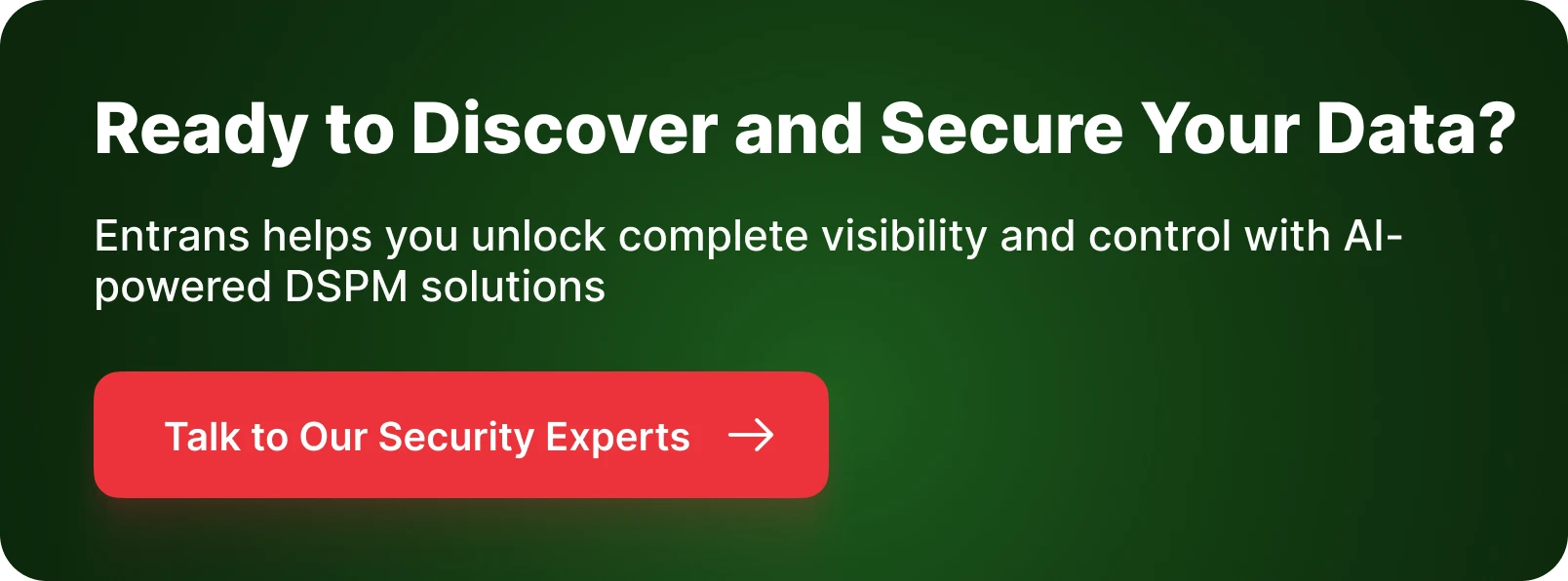


Companies store sensitive information like customer details, financial information, and employee details. Now a customer asks, 'Where is my data being stored?' Is it secure? Who has access to it ?.
Many companies can’t answer it confidently. Data Security Posture Management (DSPM) gives answers to all these questions. It helps businesses to track their information, make it safe, avoid breaches, and meet security regulations. DSPM gives a smarter and automated way to find, examine, and fix data risks.
Let’s see what DSPM is, what it does, and how it helps in saving time and costs in this post.
Data Security Posture Management (DSPM) is a security approach that enables organizations to continuously monitor, access, and secure sensitive data across both cloud and on-premises. It provides visibility into where the critical data is located, who can access it, and how it is being protected.
Some practical examples of DSPM are

The core functionalities of Data Security Posture Management (DSPM) can be grouped under five basic stages.
DSPM, Cloud Security Posture Management (CSPM), Data Loss Prevention (DLP), and Cloud Infrastructure Entitlement Management (CIEM) all sound similar in terms of security, with some differences in their main focus, core functionality, where they operate, and what it does not do.
DSPM is gaining importance due to the following benefits
Some common challenges/mistakes faced by an organization while implementing cloud DSPM solutions are
Implementation and management of Data Security Posture Management solutions across various platforms involves careful planning, stakeholder engagement, and automation. A successful deployment will require a basic steps to be followed.
DSPM is mission-critical in 2025 due to increasing data threats and complexities. Key reasons why DSPM is unavoidable include:
Data is the most valuable and vulnerable asset; protecting it is a continuous and dynamic process. To keep track of critical data and ensure that it is safe, use DSPM. DSPM is no longer optional; it is a key initiative for managing escalating data risks, supporting compliance, and enabling resilient business operations in a data-driven world.
Implementing DSPM at scale can be complex; it requires technical expertise, strategy, and the right data security management posture vendor. Entrans brings the expertise, tools, and required ongoing support to do that.
Choose DSPM to stay secure and scale with confidence. Choose Entrans to achieve it faster. Want to know more about. Book a consultation call with us to secure your data and be sustainable.
DSPM in cybersecurity works by identifying and monitoring sensitive data across environments and on-premises. It scans data continuously, classifies it, and alerts the team when there are any vulnerabilities.
DSPM enhances cloud security by giving clear visibility of where the sensitive data resides and who can have access to it. This approach reduces data exposure and strengthens the overall governance in complex cloud data environments.
The benefits of Data Security Posture Management (DSPM) are that it uses a data-first approach, offers visibility and control, reduces potential risks, and automates remediations of misconfigurations and access issues.
A good DSPM solution for hybrid and multi-cloud environments should offer automated data discovery across all environments. Its key features include continuous risk assessment, prioritization based on data security, and seamless integration with traditional data security tools.
DSPM, CSPM, CIEM, and DLP differ in terms of their main focus. In simple terms, Data Security Posture Management is data-centric, CSPM is cloud infrastructure-centric, CIEM is identity-centric, and DLP is data movement-centric.
Core components of the DSPM solution include data discovery and classification, risk analysis, its prioritization, access control, and prevention.
Choosing the right DSPM solution for your organization depends on data architecture, whether it supports all environments and integrates smoothly with existing security tools.
DSPM offers significant value by providing critical visibility and control over sensitive data. It helps organizations to improve their data security posture.
Data Security Posture Management (DSPM) differs from traditional data security tools in terms of its data-centric approach. Traditional data security tools focus on securing the infrastructure or preventing data leakage where whereas DSPM focuses only on data.
For companies with a limited budget, choosing a correct DSPM cloud solution can be challenging, as many tools are expensive. Open-source or light-weight DSPM tools like Open Raven or integrated features in cloud-native platforms (e.g., AWS Macie, Azure Purview) offer cost-effective options.





